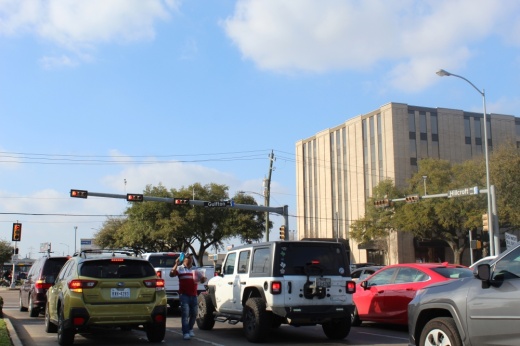According to an August 2020 Harris County heat mapping study, Gulfton was the hottest neighborhood in the county, 17 degrees warmer than the coolest areas. A 2022 community air monitoring program done by the environmental nonprofit Air Alliance Houston found the average ozone pollution levels in Gulfton were the highest compared to other Houston communities. A major source of Gulfton’s ozone included high traffic and urban heat islands.
“Sun is coming directly on concrete, bouncing back and increasing heat in that area,” said Inyang Uwak, Air Alliance’s research and policy director.
High ozone levels can lead to a range of negative health effects, according to Air Alliance, and can worsen conditions such as bronchitis and asthma. On Feb. 7, the U.S. Environmental Protection Agency announced new national air quality standards that puts Harris County in noncompliance.
Two-minute impact
In a 2023 health disparities annual report released by the Harris County Public Health department, officials said the conditions of where people live and work can have significant effects on one’s health and overall quality of life. Air pollution also impacts residents’ health care costs, according to researchers with Air Alliance Houston.
In AAH’s December 2023 report, researchers cited emissions from 47 industrial facilities in eastern Harris County cost the community more than $313 million annually in asthma-related medical expenses. Uwak said Harris County is inundated with multiple sources of fine particulate matter.
“It affects almost every system of the body,” Uwak said. “It’s a very, very tiny particle. What makes this particle very dangerous to health is when you inhale the particles, it can easily pass through all the protections in your respiratory tract.”
Harris County Public Health Director Barbie Robinson said she believes commitment from policymakers, industry professionals and community partners must be made to address these issues.
“Leadership from all groups must make a concerted effort to improve environmental conditions and address the health disparities caused or exacerbated by air pollution,” she said.
Researchers with the environmental advocacy group Environmental Defense Fund found large areas in Harris County with fine particulate matter levels above 10 micrograms per cubic meter annually. They also found parts of southwest Harris County above the 12 micrograms per cubic meter level.
While the EPA’s new annual air quality standard—announced Feb. 7—requires no more than 9 micrograms per cubic meter, Harris County was found at 11.4 micrograms per cubic meter annually, based on 2020-22 EPA air quality data.
The World Health Organization’s standards for annual air pollution level of exposure is no more than 5 micrograms per cubic meter.
The details
With limited trees and green space, pedestrians have little to no shade to provide relief from Houston’s heat, Air Alliance Houston officials said. Public transportation users in Gulfton often find themselves waiting on a sidewalk for the bus with no covering as vehicles zoom by a few feet away.
“Think about vehicle traffic,” Uwak said. “Nitrogen oxides and volatile organic compounds are released from cars, vehicles and diesel engines. You have those in the air. Then there’s excess heat because there’s very little green space to control some of that heat.”
Following a 2022 community air monitoring program done by environmental group Air Alliance Houston, three key pollutants were found to contribute to urban heat island effects in Gulfton.
- Nitrogen oxide (NOx): Gases released from vehicle exhaust, burning fossil fuels
- Breathing NOx can cause coughing, shortness of breath, tiredness and nausea.
- Volatile organic compounds (VOC): Highly reactive carbon compounds released by vehicle exhaust, refineries and other industrial sources
- Breathing VOCs can damage the central nervous system, liver, kidneys and other organs. Some VOCs can cause cancer.
- Ozone: Nitrogen oxide and volatile organic compounds released by vehicles, refineries and other industries, combined with heat and sunlight
- Ozone can cause chest pain, coughing, throat irritation and congestion, and can worsen bronchitis, emphysema and asthma.
Ten Texas counties do not meet the EPA’s revised annual levels based on 2020-22 federal air quality monitoring data that federal officials say are meant to better protect communities across the country:
- Bowie County
- Cameron County
- Dallas County
- El Paso County
- Harris County
- Hidalgo County
- Kleberg County
- Tarrant County
- Travis County
- Webb County
Quote of note
Community leaders, Gulfton residents, government agencies and nonprofits are collaborating to support a future Gulfton that will combat the high temperatures and improve the neighborhood with the Greener Gulfton plan.
Gulfton Super Neighborhood President Sandra Rodriguez said the goal is to incorporate trees as a priority. Elements of the plan will be carried out by different entities along different timelines based on when and how officials are able to secure funding.
“The goal is to plant over 800 trees," Rodriguez said. "Tree planting will help advance climate resiliency and nature equity for Gulfton.”
By the numbers
Officials with the Greener Gulfton plan said to combat impacts from the urban heat island effect, more innovative strategies are needed for trees and vegetation to develop.
- 17 degrees is how much hotter Gulfton is on average than the coolest part of the Harris County, based on data from an August •2020 heat mapping campaign.
- 86 acres of park space are needed to be added in Gulfton to meet a Houston Parks Master Plan recommendation.
- 4% is the total amount of tree shade space in Gulfton, less than other parts of Houston
- 20-45 degrees is how much experts say surface temperatures can potentially be lowered by planting more vegetation in an area.
In 2023, Harris County Precinct 4 Commissioner Lesley Briones secured $6 million in federal funding from the American Rescue Plan Act to combat the negative health and environmental effects of urban heat islands in three neighborhoods in southwest Houston—Alief, Gulfton and Sharpstown. Rodriguez said each neighborhood was allocated $2 million.
Burnett Bayland Park is one of Gulfton’s only green spaces. Precinct 4 officials are working on completing the final design this spring for the Burnett Bayland Park Master Plan that includes doubling the park’s footprint by 2027.
On Feb. 27, Harris County also accepted $238,750 in EPA grant funding as part of the Houston-Galveston Area Council’s Climate Action Plan. The county will use the funding to study climate pollution reduction efforts, including emissions reductions.





